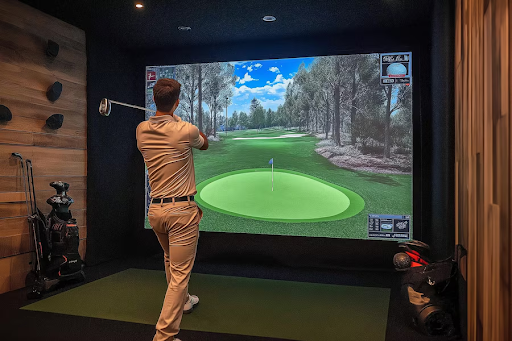Golf simulators are changing how golfers practice and enjoy the game. Perfect for both home use and professional training, these devices allow you to experience a round of golf indoors, regardless of the weather. With advanced technology, golf simulators bring the course to you, offering entertainment, skill-building, and more. In this guide, we’ll explore everything from how golf simulators work to the benefits they offer and tips for choosing the right one.
How Does a Golf Simulator Work?
Golf simulators use advanced technology to create a realistic golfing experience. Here’s how they work:
- Main Components: A typical golf simulator setup includes simulator hardware, motion detection technology, and golf simulation software. The hardware captures data from your swing, including speed, launch angle, and spin, while the software recreates these elements on a virtual course.
- Motion Detection and Swing Analysis: Advanced simulators use motion detection technology and swing analysis tools to track details of your swing. This technology captures each aspect of your shot, providing feedback to help you improve.
- Golf Course Data and Graphics: The software processes your swing data and simulates it on a virtual course. Many simulators come with detailed golf course data from famous courses around the world, allowing you to play on courses you might not visit in real life.
Golf simulators combine hardware and software to create a complete golfing experience, helping players of all levels enjoy the game and improve their skills.
Benefits of Using a Golf Simulator
Using a golf simulator has many advantages for golfers, from beginners to seasoned players:
- Practice Anytime, Anywhere: Since simulators are used indoors, you can practice regardless of weather. They allow for year-round practice, which can help you improve faster.
- Skill Improvement: With features like swing analysis tools and golf simulator accuracy, you receive detailed feedback on each shot. This helps identify areas for improvement, allowing you to work on specific skills.
- Entertainment and Training: Golf simulators offer virtual golf training on realistic courses, combining training with entertainment. You can compete with friends or family, making it a fun experience for everyone.
- Perfect for All Skill Levels: Simulators can be adjusted to fit beginners who need guidance or advanced players who want detailed feedback.
Types of Golf Simulators: Finding the Right Fit for You
There are various types of golf simulators, each designed for different needs. Here’s a look at the main categories:
Indoor vs. Outdoor Golf Simulators
- Indoor Golf Simulators: These simulators are designed for home setups in areas like garages, basements, or dedicated rooms. They are ideal for year-round practice.
- Outdoor Options: Some simulators can also be used outdoors, provided you have sufficient space. This option allows for more flexibility, especially in good weather.
Affordable vs. High-End Golf Simulators
- Affordable Golf Simulators: If you’re on a budget, there are many affordable golf simulators that offer essential features without breaking the bank. These are ideal for casual players or beginners.
- Professional Simulators: High-end simulators come with advanced technology, including golf simulator accuracy and lifelike graphics. They are more costly but are great for those serious about improving their game.
Choosing for Beginners vs. Professionals
- For Beginners: Look for user-friendly models with guided practice modes and basic golf simulation games. These simulators provide helpful insights without overwhelming new players.
- For Advanced Users: For professionals or advanced players, high-accuracy simulators with detailed swing metrics are ideal. These models offer comprehensive feedback, perfect for refining skills.
Setting Up Your Golf Simulator at Home
Setting up a golf simulator at home can transform any room into a personal golf course. Here’s what you need to know:
Golf Simulator Room Requirements and Setup Guide
The space required for a golf simulator setup depends on the model, but generally, you’ll need a room with enough height, width, and length to swing comfortably.
- Room Requirements: Most simulators recommend a ceiling height of at least 10 feet. The room should be wide enough to allow for a full swing without restrictions.
Installing and Customizing Your Golf Simulator
Setting up a simulator at home involves installing the sensors, projector, and netting. Here’s a basic setup guide:
- Choose the Right Location: Find a room with adequate space, such as a garage or basement.
- Install the Hardware: Set up the sensors, hitting mat, and any protective screens.
- Customize for Your Space: Some simulators are designed for compact areas, so if you’re short on space, look for portable golf simulator options or models for small spaces.
Key Features to Look for in Golf Simulator Software
The software is what brings the golfing experience to life. Here’s what to look for in a quality golf simulator software:
- Realistic Graphics and Course Selection: High-quality software will include detailed golf course data and realistic graphics that make virtual golfing feel like the real thing. Some simulators come with dozens of courses.
- Swing Analysis and Motion Detection: Look for software that includes swing analysis tools and motion detection technology. This feature provides accurate feedback on each shot.
- Game Modes and Practice Drills: Many simulators offer game modes and practice drills. These can range from simple putting practice to full rounds on famous courses, adding both fun and training value.
Choosing the Right Golf Simulator: Buyer’s Guide
Buying a golf simulator is an investment, so consider the following factors to make an informed decision:
- Budget: Decide how much you’re willing to spend. Affordable golf simulators offer essential features, while high-end models provide advanced tracking and realistic graphics.
- Accuracy and Technology: If precise feedback is important, consider a model known for golf simulator accuracy. High-end models with swing analysis offer the most accurate data.
- Space and Setup Needs: Ensure the simulator you choose fits comfortably in your space. Room requirements vary, so measure your space and confirm it meets the simulator’s specifications.
- User Reviews: Reading indoor golf simulator reviews can provide insight into each model’s pros and cons from real users.
Frequently Asked Questions
Here are answers to some common questions about golf simulators:
- How accurate are golf simulators compared to real golf? High-end models are highly accurate, simulating real-life ball flights and swing data.
- Can a golf simulator be used for professional training? Yes, many professional golfers use simulators for training because of the detailed feedback they provide.
- What should you consider before buying a golf simulator? Consider factors like budget, available space, and the features that matter most to your practice.
Conclusion
A golf simulator offers an engaging and flexible way to practice. With the right setup, you can enjoy golfing year-round, work on your skills, and have fun with friends and family. Take your time evaluating your options, and find a simulator that fits your space, budget, and golfing goals to make the most of your at-home practice.












